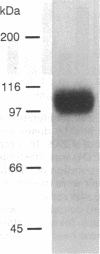Abstract
The addition of a soluble recombinant CD26 (sCD26) enhanced proliferation of peripheral blood lymphocytes induced by the recall antigen tetanus toxoid. sCD26 itself did not provide a mitogenic signal and did not augment the proliferative response of T cells to other mitogenic stimuli such as phytohemagglutinin and anti-CD3. Dipeptidyl peptidase IV-negative sCD26 did not have this enhancement effect, implying a requirement for enzyme activity. It was found that there exists a large variation in the levels of human plasma sCD26/dipeptidyl peptidase IV in vivo which may regulate T-cell activity. Peripheral blood lymphocytes from individuals whose plasma sCD26 was high and responded strongly to tetanus toxoid stimulation were insensitive to the enhancing effects of exogenously added sCD26. This suggests that plasma sCD26 had modulated the responsiveness of T cells of these individuals in vivo and that the endogenous plasma sCD26 regulates immune responses by allowing antigen-specific T cells to exert a maximal response to their specific antigen.
Full text
PDF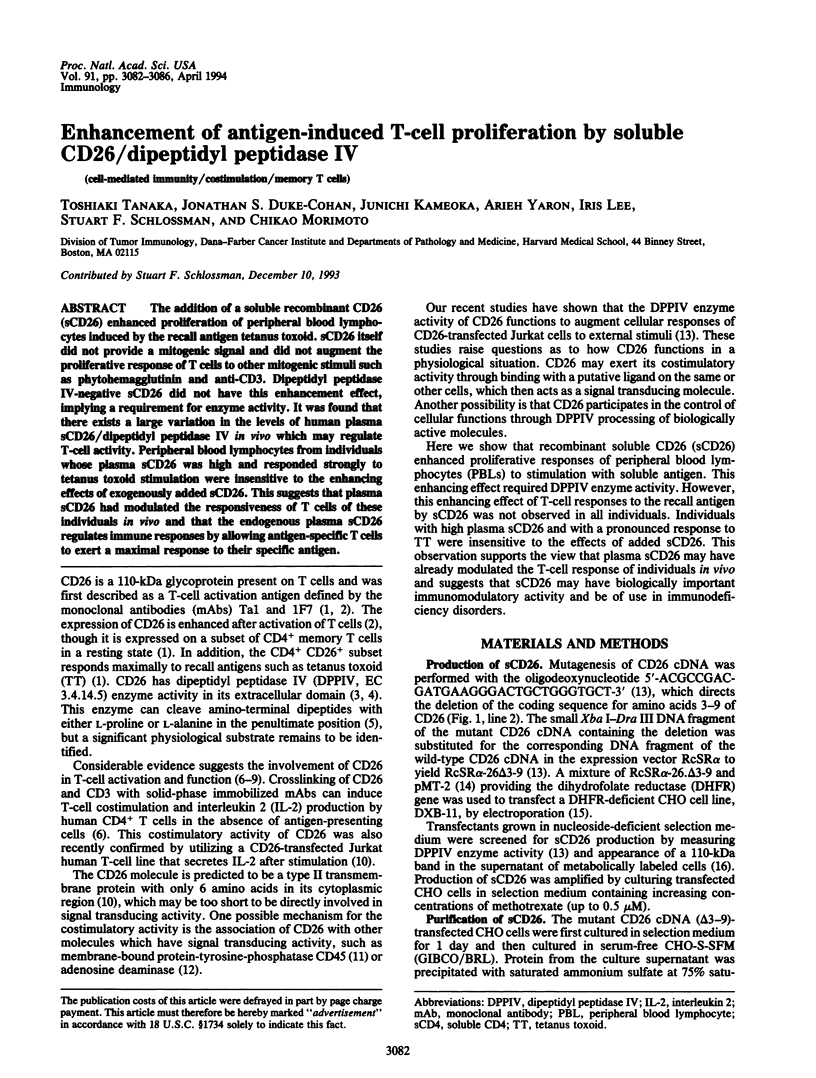
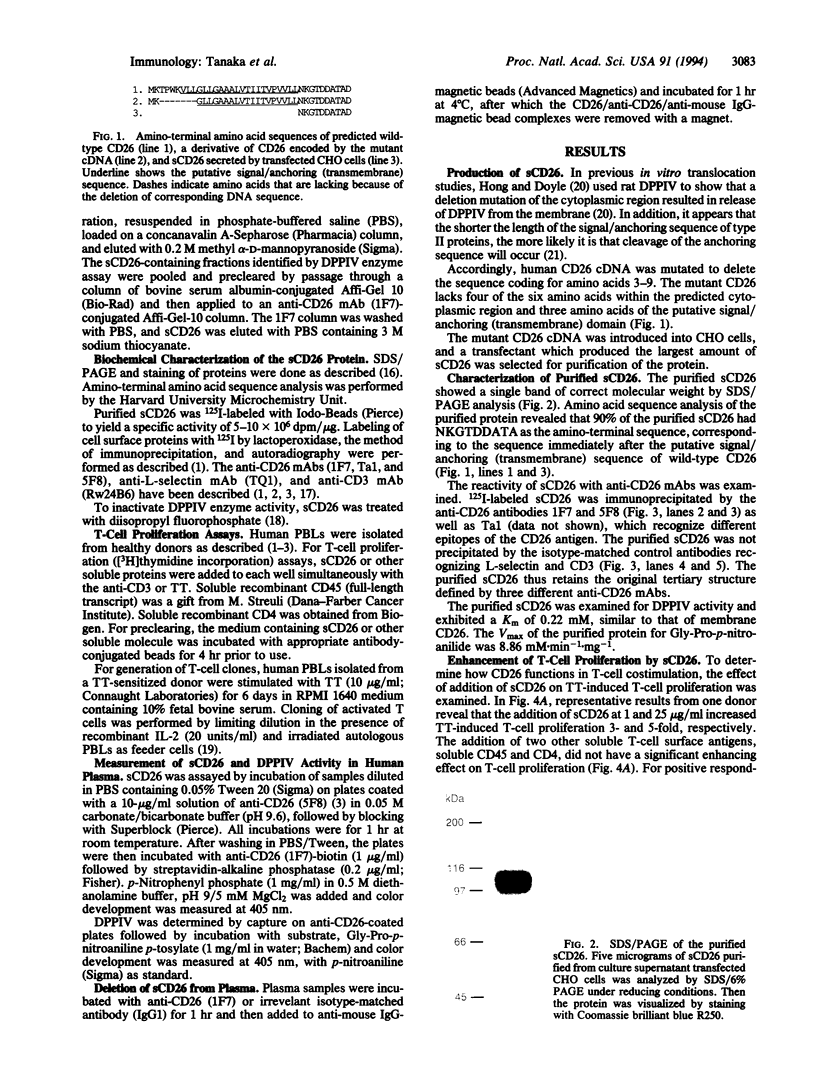
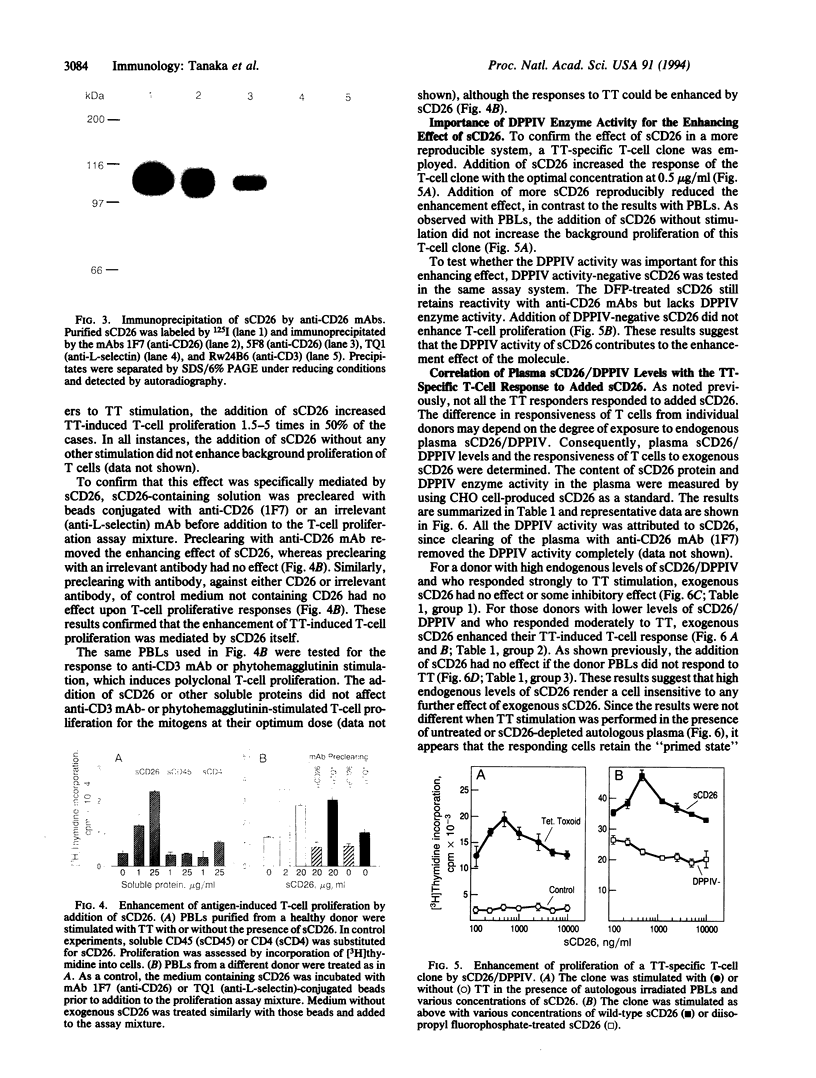
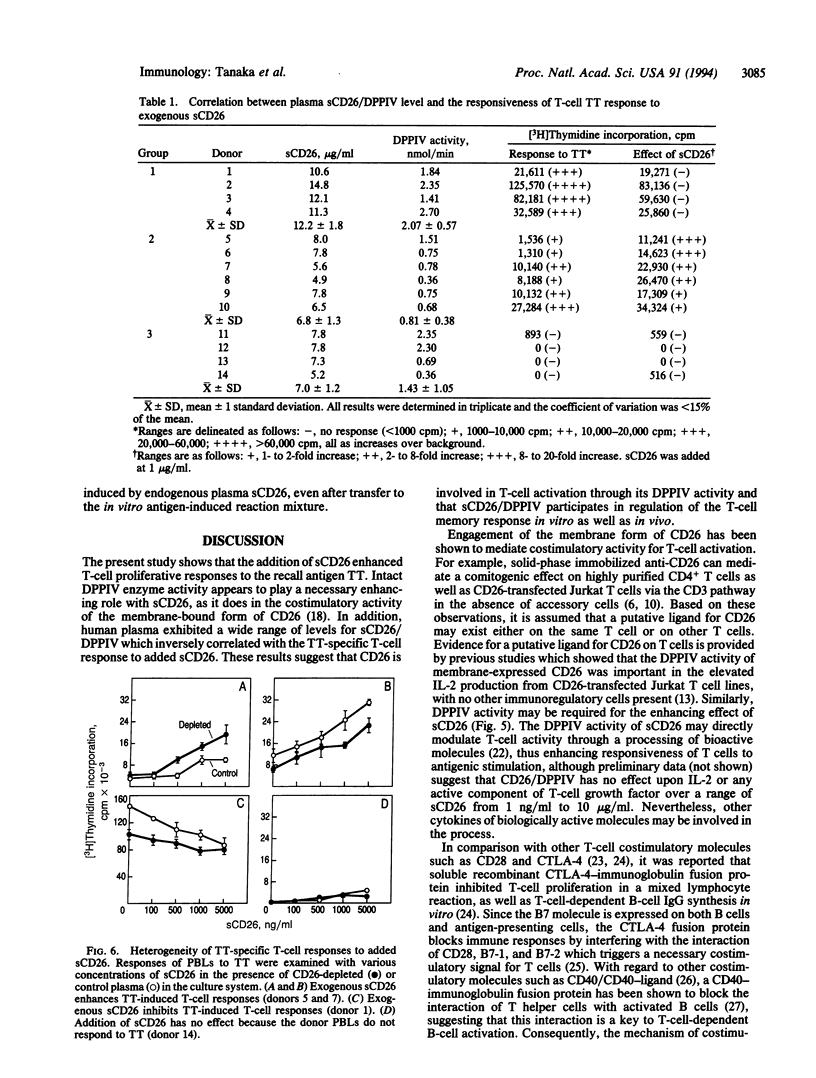
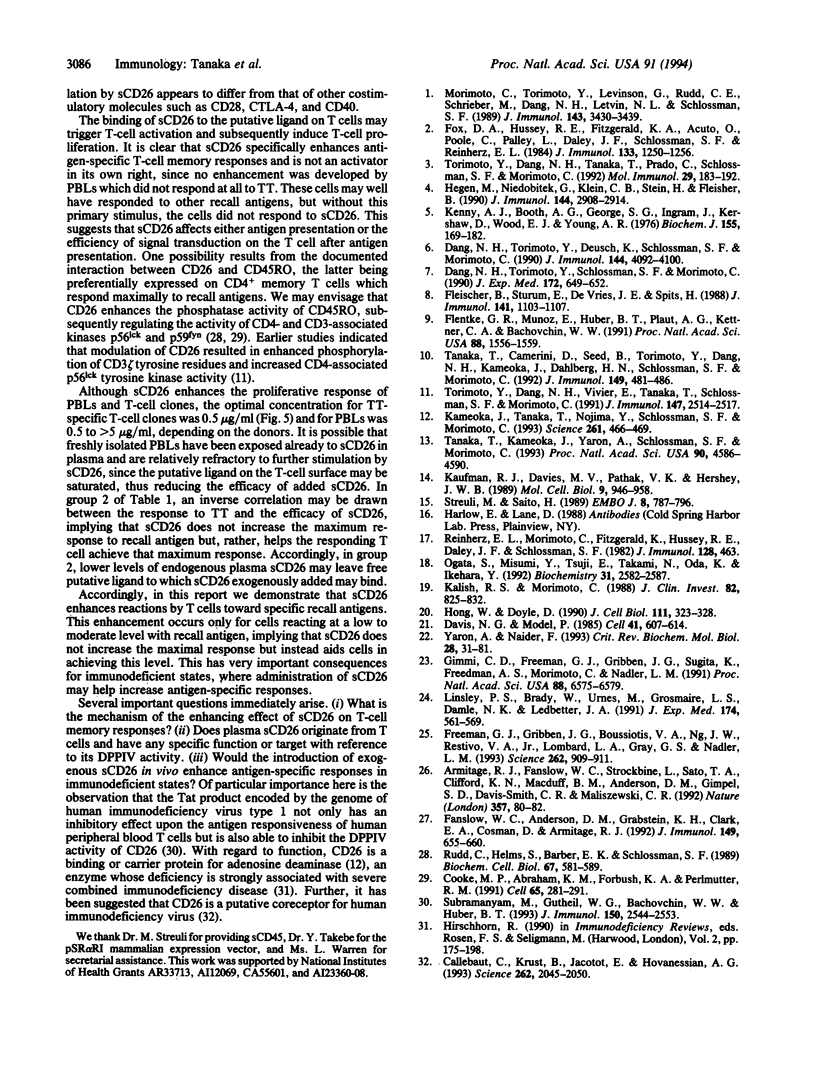
Images in this article
Selected References
These references are in PubMed. This may not be the complete list of references from this article.
- Armitage R. J., Fanslow W. C., Strockbine L., Sato T. A., Clifford K. N., Macduff B. M., Anderson D. M., Gimpel S. D., Davis-Smith T., Maliszewski C. R. Molecular and biological characterization of a murine ligand for CD40. Nature. 1992 May 7;357(6373):80–82. doi: 10.1038/357080a0. [DOI] [PubMed] [Google Scholar]
- Callebaut C., Krust B., Jacotot E., Hovanessian A. G. T cell activation antigen, CD26, as a cofactor for entry of HIV in CD4+ cells. Science. 1993 Dec 24;262(5142):2045–2050. doi: 10.1126/science.7903479. [DOI] [PubMed] [Google Scholar]
- Cooke M. P., Abraham K. M., Forbush K. A., Perlmutter R. M. Regulation of T cell receptor signaling by a src family protein-tyrosine kinase (p59fyn). Cell. 1991 Apr 19;65(2):281–291. doi: 10.1016/0092-8674(91)90162-r. [DOI] [PubMed] [Google Scholar]
- Dang N. H., Torimoto Y., Deusch K., Schlossman S. F., Morimoto C. Comitogenic effect of solid-phase immobilized anti-1F7 on human CD4 T cell activation via CD3 and CD2 pathways. J Immunol. 1990 Jun 1;144(11):4092–4100. [PubMed] [Google Scholar]
- Dang N. H., Torimoto Y., Schlossman S. F., Morimoto C. Human CD4 helper T cell activation: functional involvement of two distinct collagen receptors, 1F7 and VLA integrin family. J Exp Med. 1990 Aug 1;172(2):649–652. doi: 10.1084/jem.172.2.649. [DOI] [PMC free article] [PubMed] [Google Scholar]
- Davis N. G., Model P. An artificial anchor domain: hydrophobicity suffices to stop transfer. Cell. 1985 Jun;41(2):607–614. doi: 10.1016/s0092-8674(85)80033-7. [DOI] [PubMed] [Google Scholar]
- Fanslow W. C., Anderson D. M., Grabstein K. H., Clark E. A., Cosman D., Armitage R. J. Soluble forms of CD40 inhibit biologic responses of human B cells. J Immunol. 1992 Jul 15;149(2):655–660. [PubMed] [Google Scholar]
- Fleischer B., Sturm E., De Vries J. E., Spits H. Triggering of cytotoxic T lymphocytes and NK cells via the Tp103 pathway is dependent on the expression of the T cell receptor/CD3 complex. J Immunol. 1988 Aug 15;141(4):1103–1107. [PubMed] [Google Scholar]
- Flentke G. R., Munoz E., Huber B. T., Plaut A. G., Kettner C. A., Bachovchin W. W. Inhibition of dipeptidyl aminopeptidase IV (DP-IV) by Xaa-boroPro dipeptides and use of these inhibitors to examine the role of DP-IV in T-cell function. Proc Natl Acad Sci U S A. 1991 Feb 15;88(4):1556–1559. doi: 10.1073/pnas.88.4.1556. [DOI] [PMC free article] [PubMed] [Google Scholar]
- Fox D. A., Hussey R. E., Fitzgerald K. A., Acuto O., Poole C., Palley L., Daley J. F., Schlossman S. F., Reinherz E. L. Ta1, a novel 105 KD human T cell activation antigen defined by a monoclonal antibody. J Immunol. 1984 Sep;133(3):1250–1256. [PubMed] [Google Scholar]
- Freeman G. J., Gribben J. G., Boussiotis V. A., Ng J. W., Restivo V. A., Jr, Lombard L. A., Gray G. S., Nadler L. M. Cloning of B7-2: a CTLA-4 counter-receptor that costimulates human T cell proliferation. Science. 1993 Nov 5;262(5135):909–911. doi: 10.1126/science.7694363. [DOI] [PubMed] [Google Scholar]
- Gimmi C. D., Freeman G. J., Gribben J. G., Sugita K., Freedman A. S., Morimoto C., Nadler L. M. B-cell surface antigen B7 provides a costimulatory signal that induces T cells to proliferate and secrete interleukin 2. Proc Natl Acad Sci U S A. 1991 Aug 1;88(15):6575–6579. doi: 10.1073/pnas.88.15.6575. [DOI] [PMC free article] [PubMed] [Google Scholar]
- Hegen M., Niedobitek G., Klein C. E., Stein H., Fleischer B. The T cell triggering molecule Tp103 is associated with dipeptidyl aminopeptidase IV activity. J Immunol. 1990 Apr 15;144(8):2908–2914. [PubMed] [Google Scholar]
- Hong W. J., Doyle D. Molecular dissection of the NH2-terminal signal/anchor sequence of rat dipeptidyl peptidase IV. J Cell Biol. 1990 Aug;111(2):323–328. doi: 10.1083/jcb.111.2.323. [DOI] [PMC free article] [PubMed] [Google Scholar]
- Kalish R. S., Morimoto C. Urushiol (poison ivy)-triggered suppressor T cell clone generated from peripheral blood. J Clin Invest. 1988 Sep;82(3):825–832. doi: 10.1172/JCI113685. [DOI] [PMC free article] [PubMed] [Google Scholar]
- Kameoka J., Tanaka T., Nojima Y., Schlossman S. F., Morimoto C. Direct association of adenosine deaminase with a T cell activation antigen, CD26. Science. 1993 Jul 23;261(5120):466–469. doi: 10.1126/science.8101391. [DOI] [PubMed] [Google Scholar]
- Kaufman R. J., Davies M. V., Pathak V. K., Hershey J. W. The phosphorylation state of eucaryotic initiation factor 2 alters translational efficiency of specific mRNAs. Mol Cell Biol. 1989 Mar;9(3):946–958. doi: 10.1128/mcb.9.3.946. [DOI] [PMC free article] [PubMed] [Google Scholar]
- Kenny A. J., Booth A. G., George S. G., Ingram J., Kershaw D., Wood E. J., Young A. R. Dipeptidyl peptidase IV, a kidney brush-border serine peptidase. Biochem J. 1976 Jul 1;157(1):169–182. doi: 10.1042/bj1570169. [DOI] [PMC free article] [PubMed] [Google Scholar]
- Linsley P. S., Brady W., Urnes M., Grosmaire L. S., Damle N. K., Ledbetter J. A. CTLA-4 is a second receptor for the B cell activation antigen B7. J Exp Med. 1991 Sep 1;174(3):561–569. doi: 10.1084/jem.174.3.561. [DOI] [PMC free article] [PubMed] [Google Scholar]
- Morimoto C., Torimoto Y., Levinson G., Rudd C. E., Schrieber M., Dang N. H., Letvin N. L., Schlossman S. F. 1F7, a novel cell surface molecule, involved in helper function of CD4 cells. J Immunol. 1989 Dec 1;143(11):3430–3439. [PubMed] [Google Scholar]
- Ogata S., Misumi Y., Tsuji E., Takami N., Oda K., Ikehara Y. Identification of the active site residues in dipeptidyl peptidase IV by affinity labeling and site-directed mutagenesis. Biochemistry. 1992 Mar 10;31(9):2582–2587. doi: 10.1021/bi00124a019. [DOI] [PubMed] [Google Scholar]
- Reinherz E. L., Morimoto C., Fitzgerald K. A., Hussey R. E., Daley J. F., Schlossman S. F. Heterogeneity of human T4+ inducer T cells defined by a monoclonal antibody that delineates two functional subpopulations. J Immunol. 1982 Jan;128(1):463–468. [PubMed] [Google Scholar]
- Rudd C., Helms S., Barber E. K., Schlossman S. F. The CD4/CD8:p56lck complex in T lymphocytes: a potential mechanism to regulate T-cell growth. Biochem Cell Biol. 1989 Sep;67(9):581–589. doi: 10.1139/o89-090. [DOI] [PubMed] [Google Scholar]
- Streuli M., Saito H. Regulation of tissue-specific alternative splicing: exon-specific cis-elements govern the splicing of leukocyte common antigen pre-mRNA. EMBO J. 1989 Mar;8(3):787–796. doi: 10.1002/j.1460-2075.1989.tb03439.x. [DOI] [PMC free article] [PubMed] [Google Scholar]
- Subramanyam M., Gutheil W. G., Bachovchin W. W., Huber B. T. Mechanism of HIV-1 Tat induced inhibition of antigen-specific T cell responsiveness. J Immunol. 1993 Mar 15;150(6):2544–2553. [PubMed] [Google Scholar]
- Tanaka T., Camerini D., Seed B., Torimoto Y., Dang N. H., Kameoka J., Dahlberg H. N., Schlossman S. F., Morimoto C. Cloning and functional expression of the T cell activation antigen CD26. J Immunol. 1992 Jul 15;149(2):481–486. [PubMed] [Google Scholar]
- Tanaka T., Kameoka J., Yaron A., Schlossman S. F., Morimoto C. The costimulatory activity of the CD26 antigen requires dipeptidyl peptidase IV enzymatic activity. Proc Natl Acad Sci U S A. 1993 May 15;90(10):4586–4590. doi: 10.1073/pnas.90.10.4586. [DOI] [PMC free article] [PubMed] [Google Scholar]
- Torimoto Y., Dang N. H., Tanaka T., Prado C., Schlossman S. F., Morimoto C. Biochemical characterization of CD26 (dipeptidyl peptidase IV): functional comparison of distinct epitopes recognized by various anti-CD26 monoclonal antibodies. Mol Immunol. 1992 Feb;29(2):183–192. doi: 10.1016/0161-5890(92)90099-j. [DOI] [PubMed] [Google Scholar]
- Torimoto Y., Dang N. H., Vivier E., Tanaka T., Schlossman S. F., Morimoto C. Coassociation of CD26 (dipeptidyl peptidase IV) with CD45 on the surface of human T lymphocytes. J Immunol. 1991 Oct 15;147(8):2514–2517. [PubMed] [Google Scholar]
- Yaron A., Naider F. Proline-dependent structural and biological properties of peptides and proteins. Crit Rev Biochem Mol Biol. 1993;28(1):31–81. doi: 10.3109/10409239309082572. [DOI] [PubMed] [Google Scholar]



